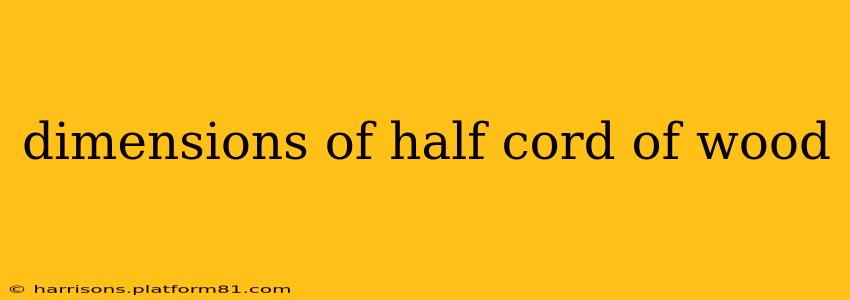A half cord of wood, also known as a "face cord," is a common unit of measurement for firewood, but its dimensions aren't standardized like a full cord. This often leads to confusion and potential for being shortchanged. Understanding what constitutes a half cord is crucial for ensuring you get the amount of firewood you pay for. This guide will clarify the dimensions and address common questions.
What are the typical dimensions of a half cord of wood?
A full cord of wood measures 4 feet (width) x 4 feet (height) x 8 feet (length). Therefore, a half cord is typically half that volume, roughly 64 cubic feet. However, the dimensions aren't fixed. You might see stacks that look like a half cord but actually contain less wood due to variations in wood splitting and stacking practices.
A common way to represent a half cord is a stack of wood that's 4 feet wide, 4 feet high, and 4 feet long. This is often what sellers describe as a "face cord," representing one face of a full cord.
How much space does a half cord of wood take up?
A half cord of wood, despite its volume of roughly 64 cubic feet, doesn't necessarily occupy that much physical space in a neatly stacked pile. The actual space occupied depends on several factors including:
- Wood species: Different tree species have different densities. Dense hardwoods will take up less space than lighter softwoods for the same volume.
- Length of the wood: Shorter pieces of wood generally take up less space than longer pieces. This is because there's more air space between the shorter logs.
- Stacking technique: Careful stacking with minimal gaps between pieces will result in a more compact pile, while sloppy stacking will leave more air gaps and thus occupy more space.
What is the difference between a half cord and a face cord?
The terms "half cord" and "face cord" are often used interchangeably, but there is a subtle difference. A half cord strictly refers to half the volume of a full cord (approximately 64 cubic feet). A face cord, on the other hand, often refers to a stack of wood that is 4 feet high and 8 feet long, but the depth (thickness) is variable and often less than 4 feet. This can significantly reduce the actual volume of wood compared to a true half cord. Always clarify with your supplier which measurement they are using.
How can I ensure I'm getting a full half cord of firewood?
To avoid being shortchanged, consider the following:
- Clearly define the terms: Before making a purchase, explicitly ask the seller to clarify whether they are selling a "half cord" (64 cubic feet) or a "face cord" (variable volume).
- Measure the stack: Measure the length, width, and height of the wood stack yourself before accepting delivery. Multiply these dimensions to get the cubic feet and compare that with the agreed-upon volume.
- Check for gaps: Inspect the stack for large gaps between logs. Excessive gaps indicate a smaller volume of wood than the apparent size.
- Use a reputable supplier: Stick to reputable suppliers with established reputations for providing honest measurements.
What is a full cord of wood?
A full cord of wood is 128 cubic feet, typically measured as 4 feet high, 4 feet wide, and 8 feet long. It's the standard unit of measurement for larger firewood orders. Understanding the full cord dimensions helps you to better understand the half-cord equivalent.
This guide helps provide clarity on the dimensions of a half cord of wood, and how it differs from a face cord. Remember to always clarify the measurements with the seller to avoid any confusion or disappointment. Accurate measurement and communication is key when purchasing firewood!
